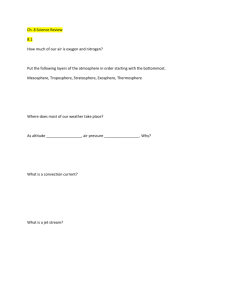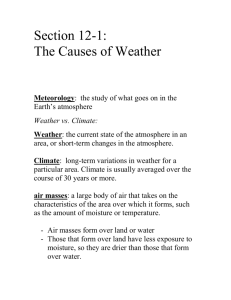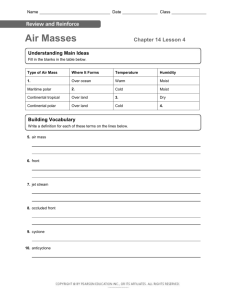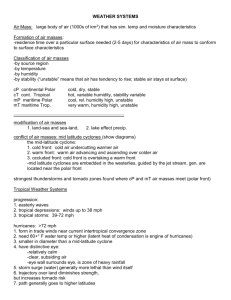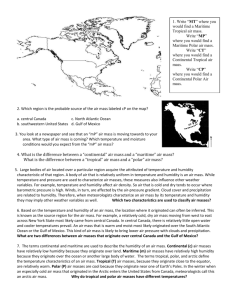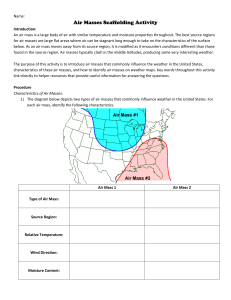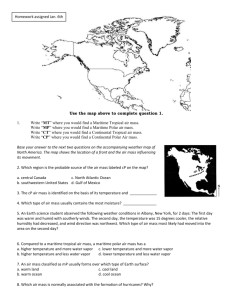Ch 24-Weather
advertisement
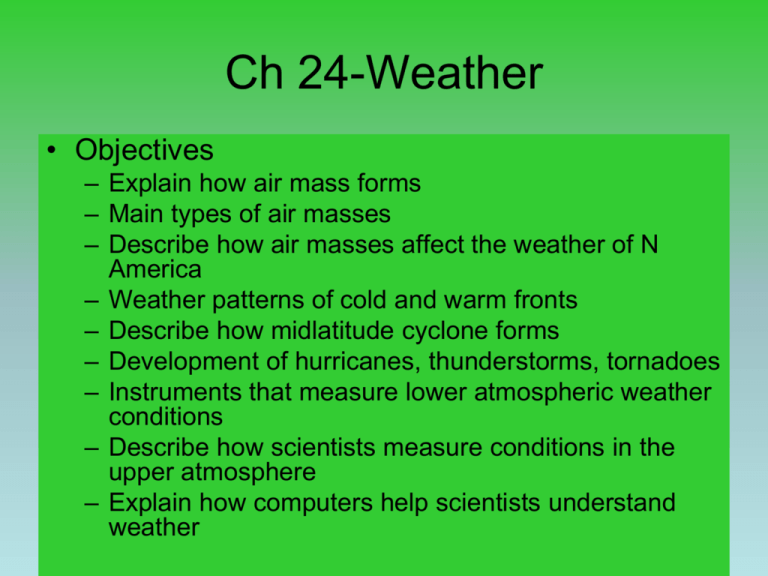
Ch 24-Weather • Objectives – Explain how air mass forms – Main types of air masses – Describe how air masses affect the weather of N America – Weather patterns of cold and warm fronts – Describe how midlatitude cyclone forms – Development of hurricanes, thunderstorms, tornadoes – Instruments that measure lower atmospheric weather conditions – Describe how scientists measure conditions in the upper atmosphere – Explain how computers help scientists understand weather • Explain how weather stations communicate weather data • Explain how a weather map is created • Explain how computer models help meteorologists forecast weather • Types of weather that meteorologists have attempted to control Air Masses • How does air move? • Formation of air masses – Air pressure differences are small=air is stationary – Stationary air takes on characteristic temp and humidity of that region • Air mass-large body of air throughout which temp and moisture content are similar • Frozen polar regions=very cold and dry • Tropical=warm and moist Types of Air Masses • Classified according to source regionsdetermines temp and humidity of air mass • Maritime-air masses that form over ocean – Humidity higher than continental – Maritime polar-moist and cold – Tropical-warm and dry • Continental-air masses that form over land, dry – Form over large landmasses. N Canada, N Asia, SW U.S. – Humidity is low, dry weather conditions – Polar-cold and dry – Tropical-warm and dry N American Air Masses • Continental tropical-form over desert, hot dry weather in summer, no winter • Maritime tropical-form over warm water of tropical Atlantic, mild cloudy weather to E U.S. in winter, hot humid weather in summer – Form over Pacific, never reach coast – Winter, maritime tropical air masses bring moderate precipitation to coast and SW deserts Polar Air Masses • Continental polar Canadian- Continental air masses form over ice and snow covered land, move into U.S. and can reach Gulf Coast • Summer, cool and dry weather • Winter, very cold weather to N U.S. • Maritime Polar Pacific-Very moist during winter on P coast, cool and foggy in summer • Maritime Polar Pacific- Cold, cloudy and snow to New England and E Canada. Summer produces cool weather w/ low clouds and fog Air Masses Of N America Air Mass Source Location Movement Weather cP Polar regions in Canada South-southeast Cold and dry mP Polar pacific; polar Atlantic Southeast; southwest-south Cold and moist cT U.S. southwest North-northeast Warm and dry mT Tropical Pacific; tropical Atlantic Northeast; northnorthwest Warm and moist Sec 2-Fronts • Front-boundary between air masses. Cool air mass is dense, does not mix w/ less dense air of warm air mass • Do not exist in tropics. Why? • Types of fronts – Cold fronts-front edge of moving mass of cold air pushes beneath warmer air mass like a wedge • • • • Cumulus and Cumulonimbus Storms short lived, violent Squall http://www.mesoscale.iastate.edu/agron206/animations/05_cnWfronts.h tml – Warm-front edge of advancing warm air mass replaces colder air w/ warmer air • Precipitation over large area, violent weather • http://ww2010.atmos.uiuc.edu/(Gh)/guides/crclm/act/gifs/fpr2.gif – Stationary front – Occluded front – Fronts Midlatitude Cyclone • Polar front-cold polar air meets tropical air mass of middle latitudes, over ocean – Wave-bend that forms in cold front or stationary front – Wave cyclones-low pressure storm centers when waves are the beginnings • Mid latitude cyclones-areas of low pressure, characterized by rotating wind that moves toward the rising air of central low pressure region – Strongly influence weather patterns in middle latitudes • Stages of Mid latitude cyclone – Lasts several days, 45 km/h in easterly direction, spin counterclock wise in N America – Move from P coast to A coast, loose moisture and energy over mts • Anticyclones-sinks and flows outward from a center of high pressure – Circulation is clockwise. Why? – Bring dry weather, sinking air does not promote cloud formation – Air pollution. Why? – May cause droughts. Why? – http://www.mesoscale.iastate.edu/agron206/a nimations/12_CycAntCyc.html Thunderstorms • Usually brief, heavy storm that consists of rain, strong winds, lightning, and thunder • 3 stages – 1st water vapor condenses to form cumulus clouds – Mature stage-Cumulonimbus clouds form, heavy rain and hailstones may fall – Dissipating stage- thunderstorm dissipates, lightning and thunder heat the air – http://glencoe.com/sec/science/earthscience/2007/co ncept_motion/animated_art/ThunderstormsDevelopm ent13_1.swf – http://www.wiley.com/college/strahler/0471480533/ani mations/ch06_animations/index.html Hurricanes • Develops over tropical oceans, winds more than 120 km/h, spiral in toward the intensely low pressure storm center • Thick cumulonimbus clouds, spiral upward toward center of storm • Eye of storm=calmest • Saffir-Simpson scale-central pressure, wind speed, storm surge, 5 categories • http://glencoe.com/sec/science/earthscience/2007/ concept_motion/NGS/Visualizing_Cyclone_Formai ton_13.swf • http://scifiles.larc.nasa.gov/kids/Problem_Board/pr oblems/weather/hurricanebasics.swf Tornadoes • Smallest, most violent and shortest lived storm • Destructive, rotating column of air, very high wind speeds, visible as funnel shaped cloud • Forms when thunderstorms meet high altitude, horizontal winds cause rising air in thunderstorm to rotate • Narrow, funnel shaped extension may touch ground, may not • Tornado Alley • What causes main destructive power? – Winds-400 km/h – http://glencoe.com/sec/science/earthscience/2007/concept _motion/animated_art/TornadoFormation13_10.swf – http://www.usatoday.com/weather/graphics/tornadoes/flas h.htm Sec 3-Weather Instruments • Measuring weather conditions – Air temp-thermometer uses mercury or alcohol, electrical thermometer, thermistor – Air pressure-barometers – Wind speed-anemometer – Wind direction-wind vane – Temp, dew pt, wind velocity-radiosone – Velocity and location of objects-radar – Weather satellites Computers • Help solve mathematical equations and describe behavior of atmosphere • Can store weather data from around world • Helpful in forecasting weather changes, store weather records for quick retrieval Sec 4-Forecasting the Weather • When do you think predicting weather forecasts came about? – 1844 by telegraph • National Weather Service – Shares info about weather conditions – Exchanges weather data w/ other nations • Global Weather Monitoring – How do weather stations communicate weather data? – Reported hourly by recording barometric pressure, speed and direction of surface wind, precipitation, temp, and humidity • World Weather Watch – Exchanges weather info in developing countries – Helps establish or improve meteorological services Weather Maps • Use data collected by weather stations and transfer to weather maps • Use symbols and colors • Cloud cover, wind speed, wind direction, precipitation, storm activities, air temp, dew pt, atmospheric pressure • Plot temp and pressure by using isotherms which are lines that connect pts of equal temp. Isobars=atmospheric pressure • Fronts=sharp changes in wind speed and direction, temp or humidity • Precipitation=colors or symbols Weather Forecasts • Plot intensity and path of weather systems on maps • Weather data-computer models show possible weather conditions for several days • Temp, wind direction, wind speed, cloudiness and precipitation-accurately • Types of forecasts – – – – – Nowcasts Daily forecasts Extended forecasts Medium forecasts Long range • Watch-issued when conditions are ideal for severe weather • Warning-severe weather has been spotted or is expected w/in 24 hrs Controlling the Weather • Cloud seeding – Most researched method for producing rain – How does this work? • Hurricane control – Seed w/ freezing nuclei in effort to reduce intensity of storm – Not attainable w/ existing technology • Lightning control – Seed potential lightning storms w/ silver iodide nuclei – No conclusive results
